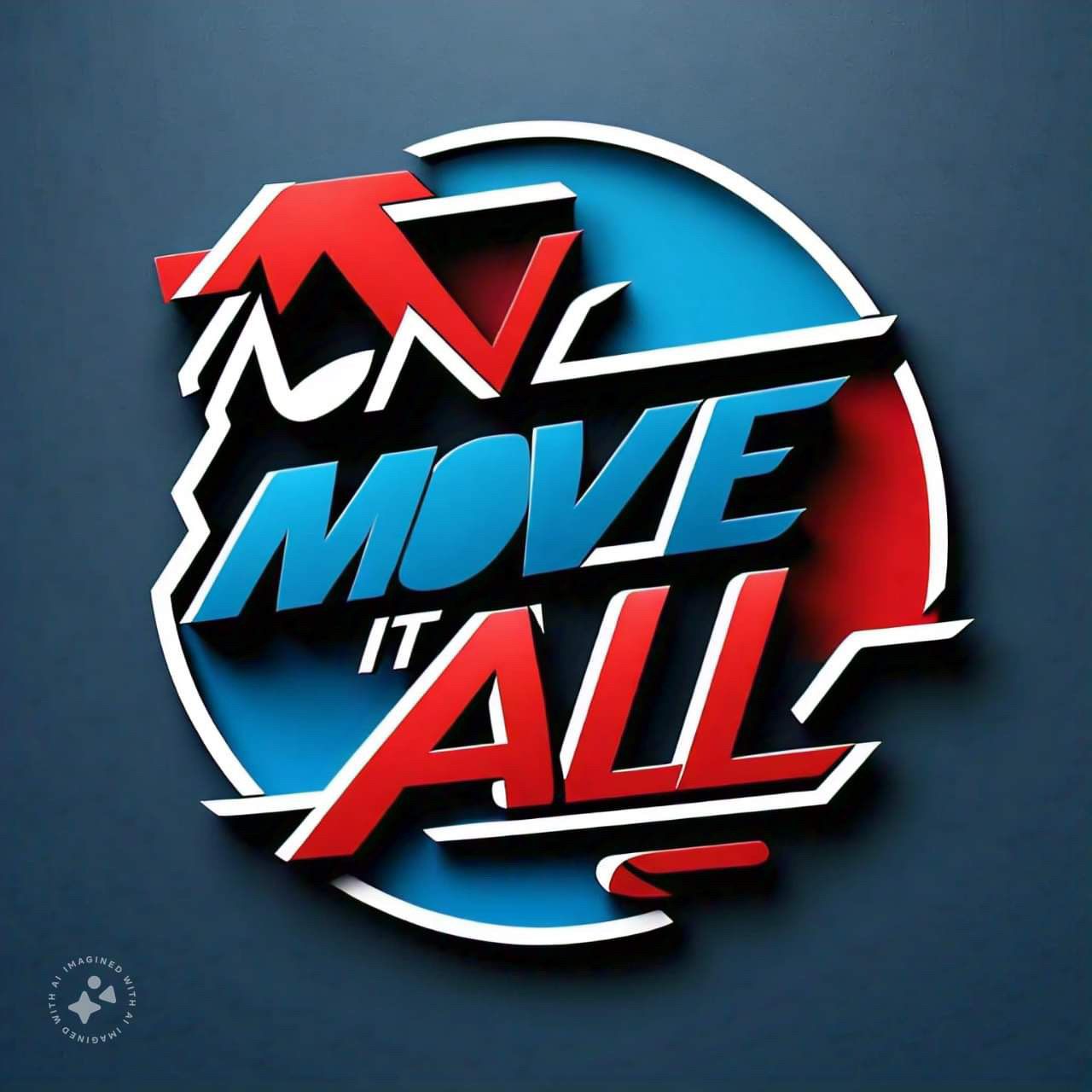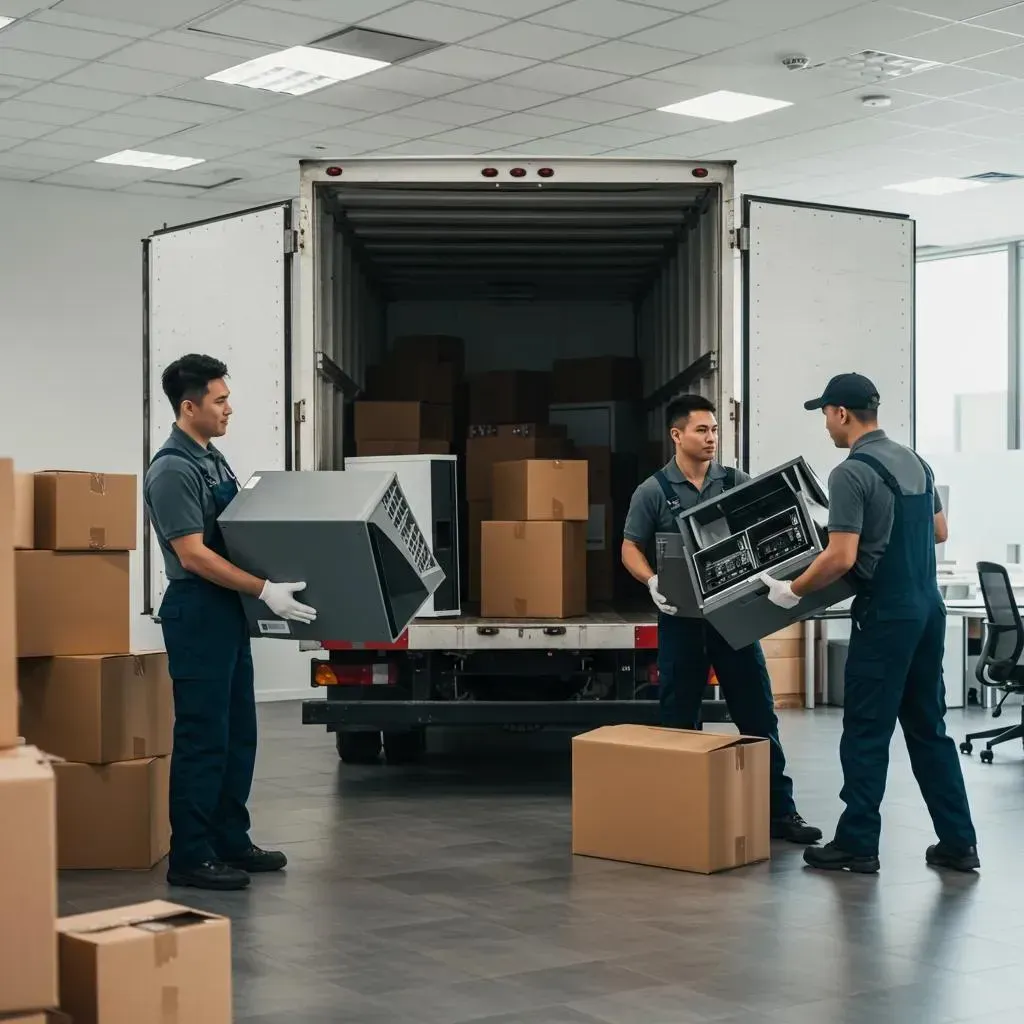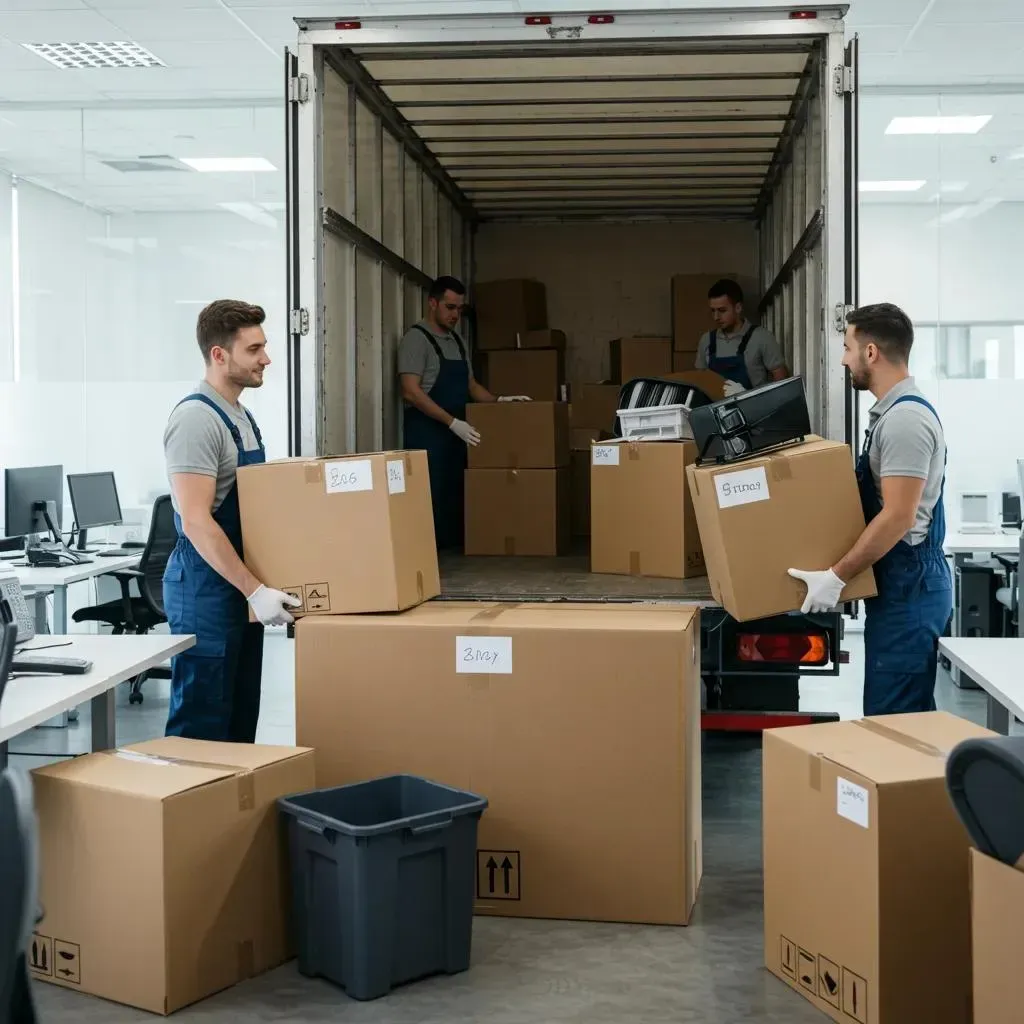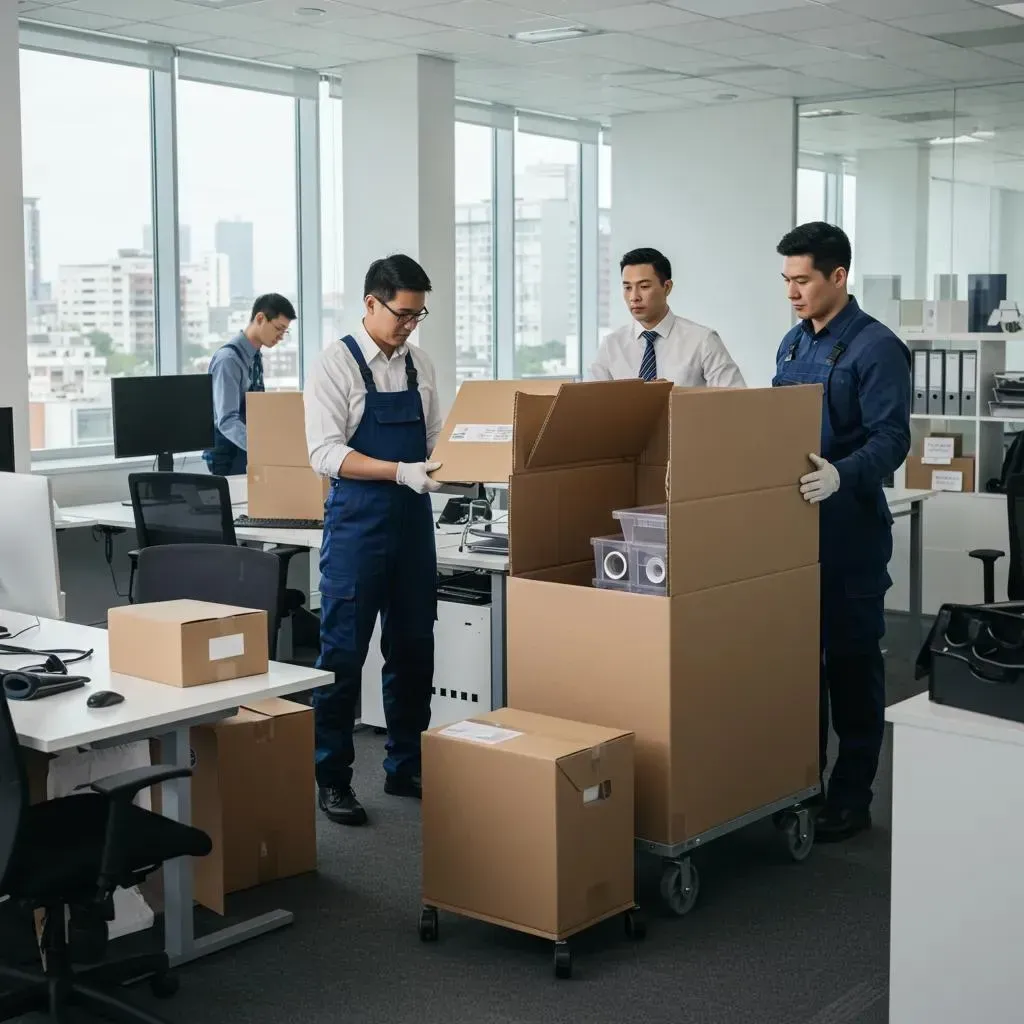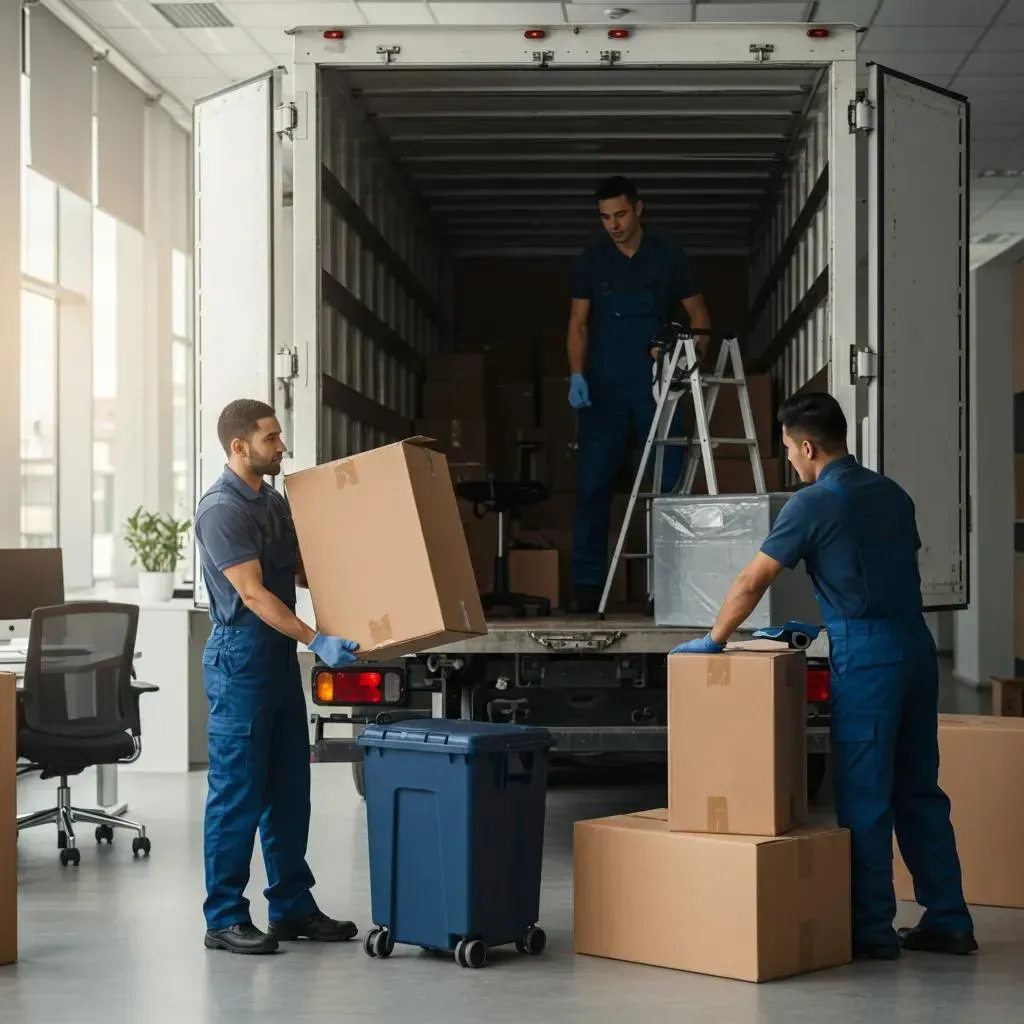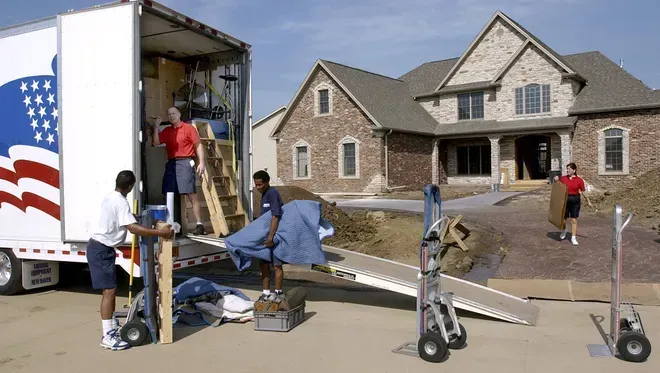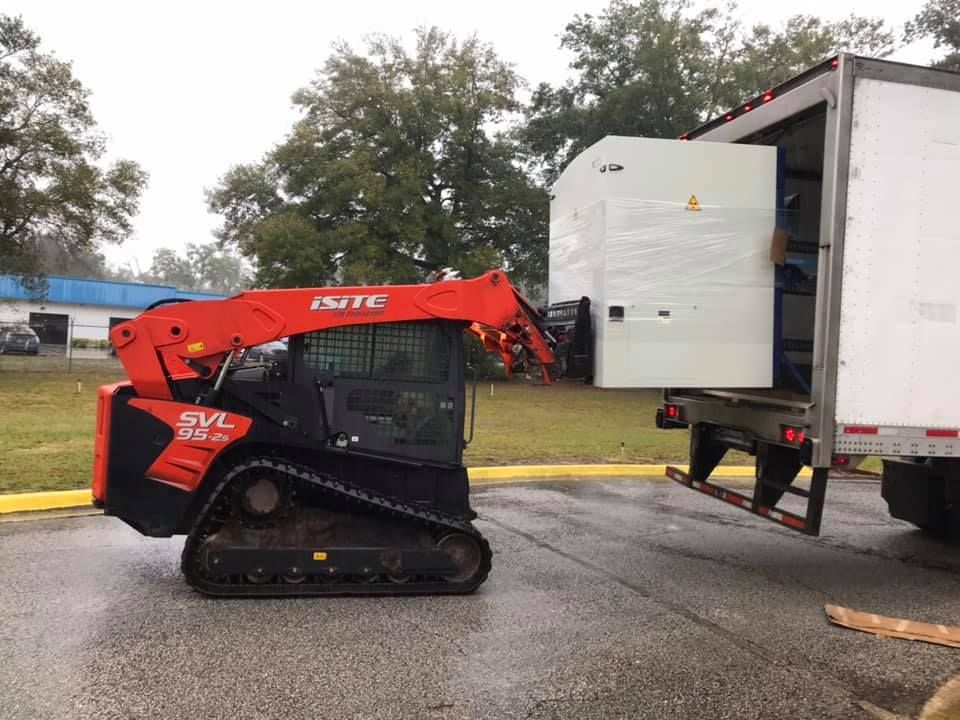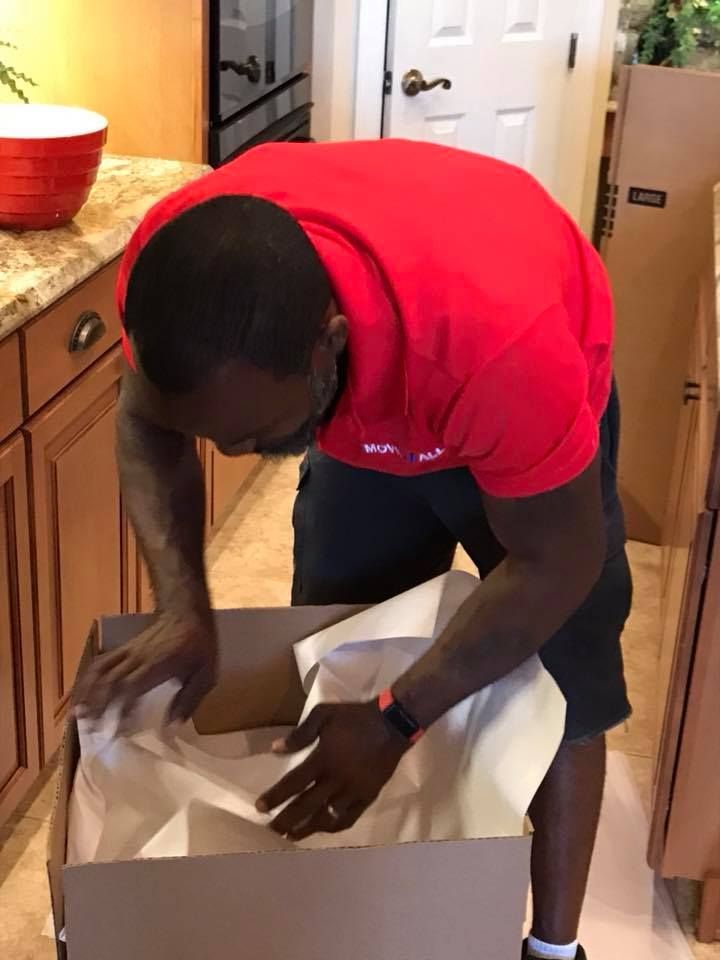BLOG
We Earned Their TRUST...
Now, Let Us Earn Yours!
Selecting the Premier Commercial Moving Company for Your Business Relocation

Pinpointing the ideal commercial moving company near me is crucial for safeguarding your valuable assets, minimizing operational interruptions, and ensuring your business continues to thrive during a structured relocation. This comprehensive guide will illuminate what a commercial moving company entails, underscore the importance of meticulous selection for uninterrupted operations, and detail how factors like licensing, proven experience, transparent pricing, specialized services, efficient office relocation workflows, and strategic packing and storage choices all converge to orchestrate a successful move. Business owners will gain a clear, step-by-step checklist for thoroughly vetting potential providers, understand the intricacies of licensing and insurance, decipher the drivers behind commercial moving costs, and identify the specialized capabilities essential for moves involving medical facilities, industrial sites, hospitality venues, and convention-scale projects. Furthermore, the article outlines practical timelines for both small and large office relocations, elaborates on secure packing and storage solutions, and provides methods for evaluating project management prowess, equipment suitability, and client testimonials to effectively mitigate procurement risks. Strategic keywords such as commercial moving company near me, Orlando commercial movers, commercial moving quote, and free on-site commercial moving estimate are seamlessly integrated to empower you in efficiently identifying and qualifying local service providers.
What Are the Essential Qualities to Seek in a Commercial Moving Company?
A commercial moving company is a highly specialized relocation service dedicated to managing business assets, sophisticated IT equipment, office furniture, and critical operational infrastructure. They employ meticulous logistics planning and deploy expert crews to ensure business continuity remains paramount. The significance of this specialization lies in the elevated stakes of commercial moves—potential for costly downtime, stringent regulatory compliance, and risks associated with sensitive equipment calibration. Consequently, selecting a mover with verified credentials, appropriate specialized equipment, crystal-clear pricing structures, and a demonstrable track record of success significantly reduces both financial and operational exposure. The tangible benefit is the assurance of predictable transition outcomes: minimized downtime, a drastic reduction in damages, and precisely managed budgets. Below, you'll find a prioritized checklist of selection criteria designed to directly enhance risk mitigation and ensure operational continuity throughout your business relocation.
By diligently verifying these criteria, you'll be far better equipped to delve into the crucial details of licensing and insurance that follow, as regulatory compliance checks are invariably the foundational step in any procurement process.
Here's a practical checklist for evaluating a commercial mover:
- Licensing and insurance meticulously verified through official registries, confirming an absence of unresolved violations.
- Relevant experience and demonstrated specialization tailored to your specific business type (e.g., medical, industrial, hospitality).
- Unwavering pricing transparency, supported by detailed written estimates and clearly defined scopes of work.
- Adequate equipment capacity and access solutions perfectly suited to your building's infrastructure and the items being moved.
- Verifiable references, compelling case studies, and documented outcomes that unequivocally prove reliability and performance.
These five foundational points establish the essential procurement framework; subsequent sections will meticulously explain how to verify licensing and insurance, guide you through interpreting USDOT and MC records, and detail the specific insurance types that offer robust protection for your valuable assets.
Why Are Licensing and Insurance Absolutely Critical for Commercial Movers?
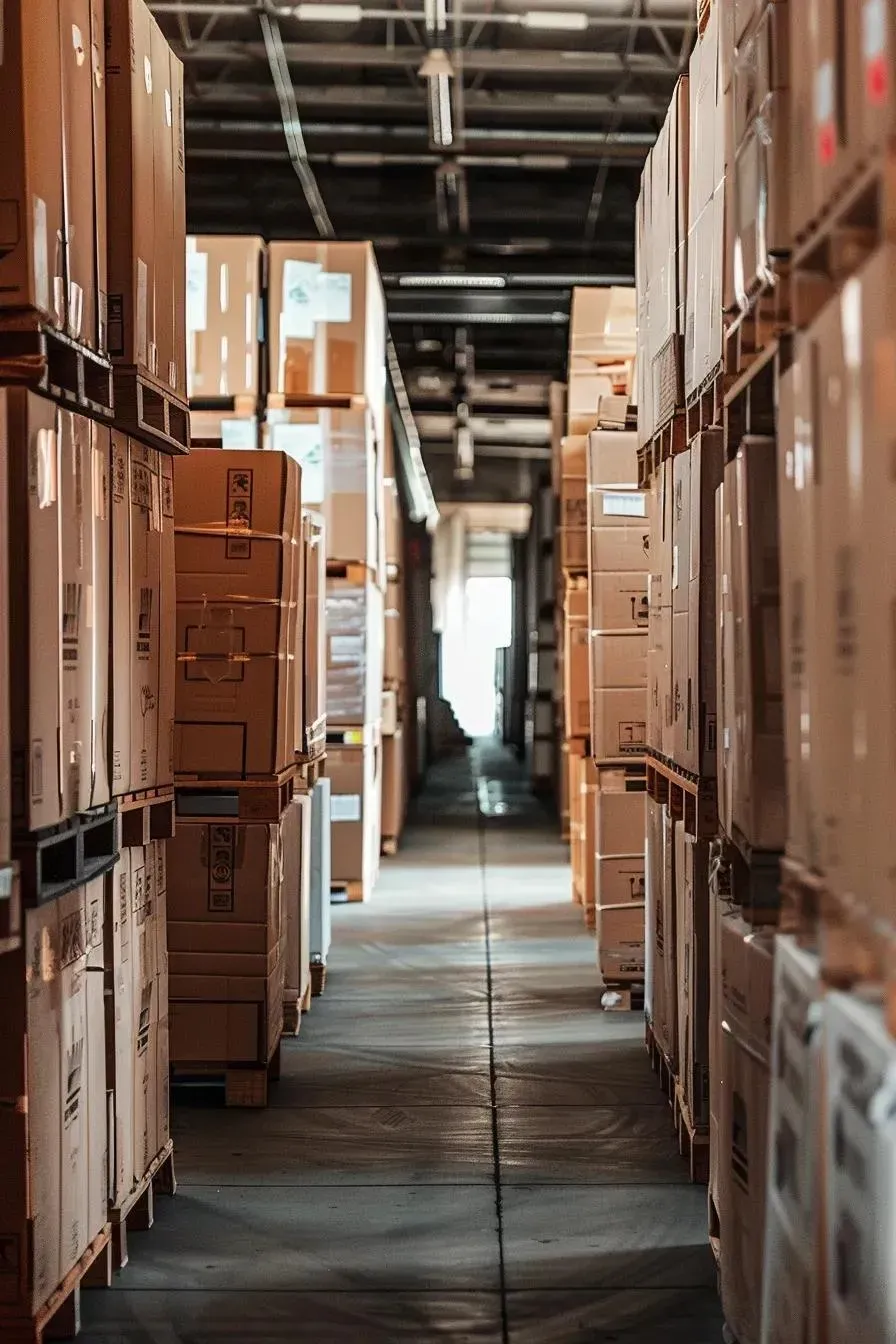
Licensing and insurance serve as the dual pillars ensuring legal operational authorization and providing essential financial safeguards in the event of loss or damage during a move. Licenses, such as federal transport registrations, serve as official confirmation that a mover adheres to regulatory obligations and is subject to ongoing oversight. Insurance policies, in turn, cover potential cargo loss, third-party liability, and worker-related incidents, collectively minimizing financial exposure for your organization. The concrete benefit derived from this is a robust risk transfer mechanism: a properly licensed and insured mover ensures that any incidents are financially manageable and that established claim processes are readily available. It is imperative to request specific documentation—current insurance certificates, detailed policy limits, and written valuation options—and to carefully note any exclusions or deductible obligations before finalizing any agreement.
Confirming the adequacy of these documents prior to awarding any work is paramount to preventing unforeseen coverage gaps and will thoroughly prepare you to effectively interpret USDOT and MC checks, which will be covered in the subsequent section.
How Can You Reliably Verify USDOT and MC Numbers for Your Business Move?
Verifying USDOT and MC numbers is a straightforward, step-by-step process that confirms a mover’s federal registration and their operating authority for both interstate and intrastate commerce. Conduct searches within official transportation registries using the mover’s USDOT and MC numbers to confirm their active status. Critically review their safety ratings and inspection history, and meticulously note any recorded enforcement actions or insurance lapses. As a prime example of what to scrutinize, MOVE IT ALL prominently displays its regulatory identifiers — USDOT # 3810487, MC # 1374983, IM # 3596 — which you can independently verify in official registry records to confirm active authority and compliance. Key red flags to watch for include expired insurance, unresolved violations, or discrepancies in business names across various documents.
Once you have successfully confirmed the registration details, the logical and essential next step is to thoroughly examine the specific insurance coverages that are designed to protect your business assets throughout the entire moving process.
What Types of Insurance Are Essential for Protecting Your Business Assets During a Move?
There are distinct categories of insurance coverage that commercial clients should unequivocally demand: comprehensive cargo insurance for goods while in transit, robust general liability coverage for any third-party damages, and valuation or declared-value coverage, which precisely dictates how claims will be processed and settled. Cargo insurance specifically covers loss or damage incurred while items are being transported. Valuation coverage establishes the definitive limit and the formula used in claim settlements. General liability addresses any property damage or bodily injury that might occur during onsite operations. It is vital to proactively inquire about policy limits, deductibles, established claim procedures, and request examples of prior claims handling to ensure that the claims processes are both effective and highly responsive.
A deep understanding of these insurance distinctions seamlessly leads into the critical assessment of a mover’s experience and specialization, as specialized moves frequently necessitate additional endorsements or significantly higher valuation limits.
How Do You Effectively Evaluate Experience and Specialization in Commercial Moving Services?
Evaluating a mover's experience involves meticulously matching their established track records and crew qualifications against the unique and specific demands of your business relocation. This ensures they possess prior experience handling similar scopes of work, specialized equipment, and navigating relevant regulatory constraints. The fundamental mechanism at play here is straightforward: businesses possessing highly specialized assets (such as sensitive servers, delicate medical devices, or complex industrial machinery) absolutely require movers who have documented, proven procedures, highly trained crews, and access to specialized rigging or handling tools to meticulously preserve function and warranty integrity. The paramount benefit realized is significantly lower risk and substantially faster recovery times: experienced providers demonstrably reduce the likelihood of rework, costly equipment recalibration, and prolonged periods of operational downtime. The following subsections will meticulously detail precisely which types of experience are most critical, how specialized equipment profoundly impacts moves, and why client testimonials and case studies serve as indispensable verification tools.
Following a thorough assessment of a mover's experience, your next crucial step is to meticulously compare concrete examples and established success criteria to rigorously validate their claims, which is precisely the focus of the testimonials and case study section.
What Specific Commercial Moving Experience Is Crucial for Different Business Types?
Distinct industries impose unique demands on mover capabilities: medical facilities necessitate meticulous calibration and seamless vendor coordination, IT firms require expert server rack handling and precise network mapping, and restaurants demand specialized appliance disconnect/reconnect services and robust refrigeration safeguards. The mechanism that imbues experience with such value is deep procedural knowledge—understanding precisely how to protect warranties, effectively schedule vendor visits, and sequence tasks to facilitate rapid reopenings. The tangible benefit is a significant reduction in operational disruption; a mover intimately familiar with your industry can proactively anticipate common pitfalls and implement specialized workflows that prevent damage and expedite the restart of operations. When evaluating potential vendors, always request documented examples of similar projects undertaken and specific, quantifiable outcomes such as reduced downtime or successful system reinstallation within agreed-upon timeframes.
Validating these claims effectively leads to a thorough review of the specialized equipment that enables safe and efficient handling, a topic we will cover in detail next.
How Does Specialized Equipment Significantly Impact Your Business Relocation?
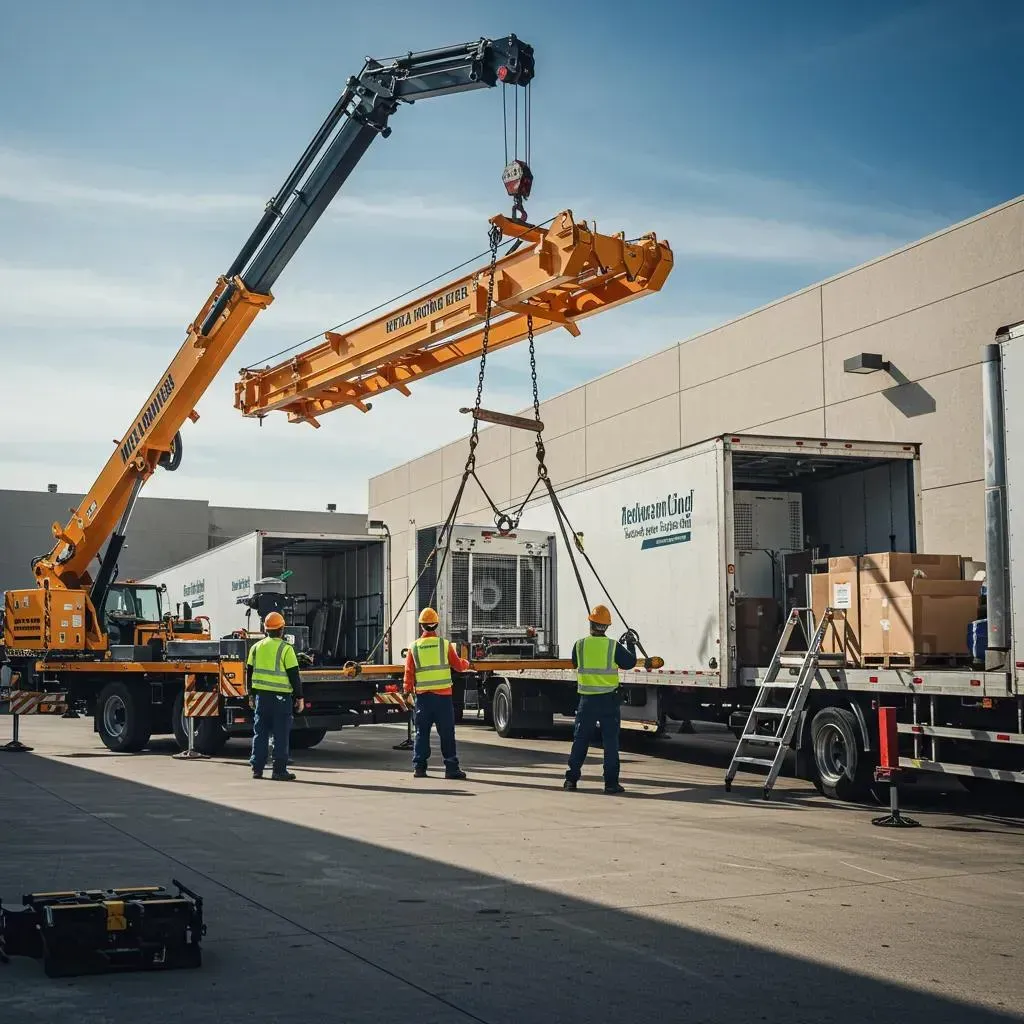
The deployment of specialized equipment—including advanced rigging kits, industrial cranes, skid-steer lifts, climate-controlled transport vehicles, and robust padded crates—fundamentally alters how high-risk items are handled and directly influences both move timelines and overall cost. The core mechanism is enhanced capability: utilizing appropriate equipment significantly reduces the need for manual handling, prevents improper loading techniques, and ensures compliance with stringent safety requirements for heavy or temperature-sensitive assets. The primary benefit is the assurance of predictable handling outcomes and a marked reduction in damage incidents; conversely, employing incorrect equipment invariably increases time, cost, and potential liability. When sourcing a mover, it is essential to request a detailed equipment manifest specifically for your project and to meticulously inspect certifications for any specialized lifting gear and climate control options being utilized.
Understanding precisely what equipment will be employed directly ties into verifiable proof of performance, which is precisely why testimonials and case studies are an indispensable final check in the vetting process.
Why Are Client Testimonials and Case Studies Absolutely Essential?
Testimonials and case studies serve to translate abstract claims into concrete, measurable results by vividly illustrating how a mover has successfully navigated real-world challenges, effectively managed complex timelines, and adeptly handled claims. The underlying mechanism is compelling evidence: well-crafted case studies meticulously detail the challenge, the implemented solution, and the quantifiable outcomes achieved (such as reduced downtime, swift move completion times, and minimal damage incidents), thereby significantly reducing perceived procurement risk. The tangible benefit is the establishment of clearer expectations and the acquisition of stronger negotiation leverage, particularly when you have specific, documented examples to reference within contract terms. Always request multi-paragraph case studies that include specific metrics and client contact information for thorough validation, rather than relying on short, generic quotes.
Concrete success stories provide invaluable insights that help you identify precisely which outcomes to demand in your contract's Service Level Agreements (SLAs) and naturally lead into examples of the success story outlines you should be requesting.
What Types of Success Stories Truly Demonstrate Reliability?
Reliable success stories consistently follow a clear and logical Challenge → Solution → Result format, meticulously highlighting measurable outcomes such as significantly reduced downtime, completed reassembly times, and a complete absence of damage incidents. For instance, a compelling story might outline the unique challenge of moving sensitive imaging equipment for a hospital, describe a meticulously coordinated plan involving multiple vendors and the moving company utilizing specialized crates and climate control, and present definitive results like the equipment being successfully reinstalled and calibrated within an impressive 48 hours. The fundamental mechanism that unequivocally proves reliability is the inclusion of measurable metrics; the benefit derived is unwavering confidence in your procurement decisions. When evaluating potential providers, always request at least three such detailed outlines and seek specific details regarding the timeline, crew size, and any permits or traffic coordination measures that were employed.
These concrete proof points also directly inform how you should meticulously evaluate pricing and quotes, which represents the next major decision area in your relocation planning.
What Crucial Information Do You Need About Transparent Pricing and Commercial Moving Quotes?
Transparent pricing for commercial moves fundamentally defines precisely how costs are calculated, which specific services are included in the overall package, and how any changes in the scope of work will impact the final billing; transparent quotes are instrumental in eliminating unwelcome surprises and ensuring budget certainty. The core mechanism is absolute clarity: a clearly defined scope and a transparent pricing model—whether hourly or a flat-fee structure—empowers you to effectively compare proposals and proactively manage potential risks. The primary benefit is the assurance of predictable budgets and robust contractual protections, such as guaranteed prices or clearly defined capped overages. Below, we will meticulously break down the key cost drivers, compare the different pricing models available, and provide a comprehensive checklist to help you prepare for requesting a free on-site estimate.
After thoroughly understanding the various cost drivers, you will be fully equipped to make an informed decision between hourly rates and flat fees, based on the certainty of your scope and your specific risk tolerance.
What Key Factors Influence Commercial Moving Costs?
Commercial moving costs are primarily influenced by several critical factors: the sheer size and weight of the inventory, the distance and travel time involved, the required crew size, the necessity for specialty handling and equipment, the need for permits and escorts, and any access challenges such as stair carries or navigating secure building entry points. Each of these factors directly contributes to increased labor hours, extended vehicle time, or the requirement for specialized equipment, all of which translate into higher overall costs. The underlying mechanism is resource allocation: greater weight and more complex access requirements necessitate larger crews and longer job durations, while specialty handling demands certified personnel and specific equipment. The significant benefit of thoroughly understanding these drivers is that it empowers you to strategically prioritize items to potentially reduce overall cost, such as staging nonessential equipment into temporary storage or scheduling overnight moves to effectively avoid traffic congestion.
To make these cost drivers exceptionally clear, please review the comparison table below, which meticulously outlines typical move categories and their estimated primary cost drivers.
| Move Type | Primary Cost Drivers | Typical Impact |
|---|---|---|
| Small Office Move | Crew size; truck size; hours worked | Moderate cost; flexible scheduling |
| Large Office/Corporate | Multiple crews; phased moves; equipment | High cost; requires project management |
| Medical Equipment Move | Specialized handling; vendor coordination; climate control | Higher cost; strict scheduling |
| Industrial Machinery Relocation | Rigging, permits, heavy equipment | Very high cost; engineering surveys required |
How Do Hourly Rates Compare to Flat Fees for Business Moves?
Hourly rates offer significant flexibility and are typically the most suitable option for smaller, less defined-scope moves where exact quantities may be uncertain; conversely, flat fees are highly effective for larger, well-defined moves where a fixed price provides unparalleled budget certainty. The core mechanism is the allocation of risk: hourly pricing strategically shifts the risk of scope expansion to the client but can often be more cost-effective for quicker, simpler jobs; flat fees, on the other hand, transfer scope risk entirely to the mover but provide clients with robust protection against escalating hourly charges. The primary benefit is that selecting the most appropriate pricing model significantly reduces the potential for disputes—opt for hourly when flexibility is paramount, and flat-fee when predictability is the key objective. To proactively avoid any unwelcome surprises, it is crucial to ensure that contracts clearly define the scope of work, establish rules for overtime, and specify any potential access-related surcharges.
Understanding these inherent trade-offs thoroughly prepares you to confidently request an on-site estimate and consistently compare proposals, a process we will meticulously explain in the following section.
How Can You Effectively Request a Free On-Site Commercial Moving Estimate?
Requesting a free on-site estimate involves several key preparatory steps: compiling a detailed inventory of all items to be moved and providing accurate floor plans, scheduling the estimator to visit during standard business hours with complete access to all areas involved in the move, and specifically requesting a written, itemized quote that clearly lists all included services, the projected crew sizes, and any underlying assumptions made. The fundamental mechanism here is thorough documentation: a comprehensive inventory, supporting photographs, and unobstructed site access enable the most accurate scope definition and, consequently, the most precise pricing. The tangible benefit is a realistic quote that minimizes the likelihood of post-move disputes. It's important to note that some providers offer complimentary on-site flat-rate estimates for larger spaces; for instance, MOVE IT ALL prominently advertises Free On-Site Flat Rate Estimates for businesses occupying spaces exceeding 2,500 sq. ft., while smaller moves may be priced using competitive hourly rates.
Once you have received written estimates, it is highly recommended to utilize contractual protections and guaranteed pricing clauses to firmly lock in the scope of work and effectively prevent any unexpected surprises.
Which Specialized Commercial Moving Services Should You Seriously Consider?
Specialized commercial moving services are meticulously designed to address the unique needs of specific sectors—including medical equipment, industrial machinery, restaurant systems, and convention-scale logistics—each demanding distinct certifications, specialized equipment, and precise planning to safeguard assets and ensure operational continuity. The underlying mechanism is deep specialization: providers with targeted capabilities significantly reduce risk and accelerate the restoration of critical services. The primary benefit is the assurance of safer, faster transitions with a substantially lower risk of warranty invalidation or compliance issues. Below, we will outline various specialized service types, highlight critical red flags to watch for, and present an EAV-style comparison table that contrasts the specific requirements and risk mitigation strategies across different service categories.
This comparative overview is designed to help you precisely select the right specialist for your industry-specific relocation needs.
What Are the Distinct Benefits of Medical Equipment Moving Services in Florida?
Medical equipment moving places a paramount focus on strict compliance, the meticulous protection of calibration settings, and seamless coordination with device manufacturers and clinical staff to guarantee that equipment remains fully functional and under warranty. The mechanism employed involves highly specialized packing techniques, sophisticated shock monitoring systems, and adherence to vendor-approved handling procedures to meticulously preserve calibration integrity and minimize the need for costly rework. The tangible benefit is significantly minimized clinical downtime and the unwavering preservation of device integrity, ensuring that patient care can resume without delay. When selecting a provider for such critical moves, it is imperative to require documented vendor coordination workflows and insurance limits that are specifically appropriate for high-value medical assets.
These requirements stand in stark contrast to industrial relocations, which place a strong emphasis on advanced rigging techniques and robust engineering controls, a topic we will explore in detail next.
How Is Industrial Machinery Relocation Managed with Utmost Safety?
Industrial machinery relocation follows a carefully structured, multi-phase process—encompassing an initial engineering survey, precise disassembly, expert rigging, secure transport, and meticulous reassembly—all supported by certified riggers, heavy-lift equipment, and necessary permits when required. The core mechanism is engineered planning and stringent safety protocols designed to effectively mitigate the inherent risks of structural damage or worker injury. The primary benefit is the assurance of predictable reinstallation and significantly minimized production loss, achieved through phased scheduling, specialized lift plans, and rigorous onsite safety management. It is crucial to ensure that providers supply comprehensive engineering surveys and detailed method statements before awarding any contracts.
With industrial moves expertly managed, restaurant and hospitality moves require distinct sequencing and specialized equipment handling to effectively support phased reopenings, a process described in detail below.
What Should You Expect from Restaurant and Hospitality Moving Services?
Restaurant and hospitality moves demand meticulous handling of refrigeration units, commercial kitchen equipment, bar systems, and fixtures, with a critical focus on sanitation, precise appliance disconnect/reconnect procedures, and strategically planned phased reopenings to prevent revenue loss. The underlying mechanism is sequenced logistics that prioritize temperature-controlled equipment and coordinate closely with contractors for essential mechanical reconnections. The tangible benefit is an accelerated reopening schedule that effectively protects perishable inventory and significantly reduces lost revenue. When vetting potential movers, it is essential to confirm their specific appliance disconnect/reconnect capabilities and their proposed sequencing plans, ensuring they align perfectly with contractor timelines.
Larger venue moves, such as those involving convention centers, necessitate sophisticated staging, precise traffic coordination, and multi-team project management, all of which we will meticulously outline in the following section.
How Do Convention Center and Large Facility Moves Differ Significantly?
Convention center and large facility moves escalate dramatically in complexity, requiring extensive staging areas, detailed traffic management plans, multi-day scheduling, and the coordination of multiple specialist crews working in parallel to meet critical event timelines. The core mechanism is sophisticated logistical orchestration—meticulously coordinating ingress/egress, vehicle staging, and security protocols to proactively prevent bottlenecks. The primary benefit is the assurance of on-schedule event readiness with minimal interference to other ongoing operations. It is imperative to insist on a robust project management structure with clearly designated leads, comprehensive traffic control plans, and a phased approach that strategically addresses peak access windows.
A thorough understanding of these specialized services effectively completes the operational overview and naturally leads into the discussion of office relocation workflows specifically tailored for businesses in Orlando.
How Can Office Relocation Services in Orlando Streamline Your Business Move?
Office relocation services are designed to meticulously coordinate planning, IT infrastructure handling, furniture reassembly, and phased transitions to significantly minimize business disruption and rapidly restore productivity. The underlying mechanism is integrated project management—which involves assigning a dedicated project manager, strategically scheduling phased moves, and coordinating critical IT cutovers to effectively manage dependencies. The tangible benefit is the assurance of streamlined transitions with crystal-clear timelines and substantially reduced downtime, enabling staff to resume their work with minimal interruption. The following subsections will meticulously describe the available solutions for small offices, the coordination strategies for large corporate moves, the intricacies of IT equipment handling, and best practices for furniture reassembly.
These fundamental operational building blocks collectively form the practical roadmap for executing any office move, whether it's a local relocation or a regional transition.
What Tailored Solutions Are Available for Small Office Moves?
Small office moves typically leverage compact crew-and-truck configurations, often supplemented with optional partial packing services and highly focused scheduling, to ensure relocations are completed both quickly and affordably. The core mechanism is lean resourcing: small, highly trained crews adept at efficient packing and rapid loading significantly reduce billable hours and effectively keep costs down. The primary benefit is the assurance of rapid turnaround times and minimal service interruption for smaller teams. Providers frequently offer partial packing services to expertly handle high-value or fragile items, while allowing internal staff to pack routine materials, thereby saving costs; it is advisable to request clear details on crew size and estimated hours to facilitate accurate bid comparisons.
Scaling up from small setups, we now turn our attention to large corporate relocations, which demand dedicated project roles and sophisticated phasing, a topic we will meticulously explain next.
How Are Large Corporate Office Relocations Coordinated with Maximum Efficiency?
Large corporate relocations strategically employ a dedicated project manager, experienced site supervisors, and comprehensive stakeholder communication plans to meticulously coordinate phased moves, employee schedules, and essential vendor tasks within a tightly controlled timeline. The underlying mechanism is role-based coordination, supported by detailed documented timelines, precise move-day scripts, and proactive contingency planning for potential delays. The tangible benefit is the assurance of predictable milestone delivery and significantly reduced business downtime through the implementation of phased waves and clear, consistent communications. It is imperative to insist on a detailed written move plan that explicitly includes designated staging areas, clear employee move instructions, and established escalation paths for addressing any unexpected issues.
IT moves must be executed with extreme precision and tightly synchronized with these phases to prevent any service interruptions, which is why the next subsection will specifically address the critical aspects of IT equipment handling.
What Is Intricately Involved in IT Equipment Moving and Setup?
IT equipment moving necessitates comprehensive pre-move data backups, meticulous labeling and mapping of all network connections, careful rack removal and secure transport, and highly coordinated reinstallation procedures in conjunction with IT teams to enable rapid and seamless cutovers. The core mechanism is proactive risk mitigation through meticulous documentation and precise sequencing: thorough backups protect invaluable data, detailed labeling prevents critical miswiring, and coordinated reinstallation significantly reduces potential downtime. The primary benefit is the assurance of a reliable cutover that restores essential network services both efficiently and securely. It is highly recommended to include a detailed checklist covering backups, labeling conventions, and post-move verification steps within your scope to ensure complete accountability.
The physical tasks of furniture disassembly and reassembly are the critical steps that follow IT cutover and staff positioning, a process we will thoroughly cover in the next section.
How Does Furniture Disassembly and Reassembly Function Effectively?
Furniture disassembly and reassembly involves a systematic process of inventorying all components, meticulously labeling each part, protecting hardware during transport, and performing rigorous quality checks after reassembly to preserve warranties and prevent costly rework. The underlying mechanism relies on systematic part tracking and the use of protective packing materials to effectively avoid missing components or damage from scratches. The tangible benefit is significantly faster workspace readiness and a marked reduction in post-move corrections. It is essential to require movers to provide a detailed parts manifest, utilize protective coverings for all finishes, and implement a comprehensive post-move inspection checklist to confirm correct and complete assembly.
Having well-defined office workflows firmly in place naturally brings focus to the crucial packing and storage options that bridge move timelines and ensure the protection of valuable assets.
What Pivotal Role Do Packing and Storage Play in Commercial Moving?
Packing and storage are absolutely essential components for safeguarding assets, effectively managing phased timelines, and providing secure bridging solutions when new spaces are not immediately available; they are integral parts of the logistical toolkit that guarantees operational continuity. The core mechanism is protective staging: professional packing significantly reduces the risk of damage, and secure storage provides crucial flexibility for phased moves or during renovation periods. The primary benefit is the assurance of preserved assets and smoother transitions that maintain the stability of business operations. Below, we will meticulously compare various packing options and storage types, and provide expert guidance on recommended supplies and the optimal times to outsource packing tasks.
Choosing the correct combination of packing and storage options is fundamentally dependent on your specific timeline constraints and the inherent sensitivity of the items being moved.
What Are the Significant Advantages of Full-Service Commercial Packing?
Full-service commercial packing utilizes highly trained crews, standardized packing materials, and insurance-backed handling procedures that demonstrably reduce move times and provide superior protection for high-value items. The underlying mechanism is professionalization: specialized crews meticulously follow established packing standards and precise labeling protocols that significantly simplify the subsequent processes of loading, transport, and reassembly. The tangible benefit is faster execution and clearer claims processes in the unfortunate event of damage, as the packing is performed to recognized industry standards. Opt for full-service packing when schedules are exceptionally tight, internal staff time is severely constrained, or when high-value/fragile assets absolutely require expert protection.
Deciding to outsource specific tasks naturally leads to an evaluation of the trade-offs involved in partial packing, which we will discuss in detail next.
When Is Partial Packing the Most Strategically Sound Option?
Partial packing proves most effective when businesses are focused on cost control while simultaneously prioritizing the protection of high-value or fragile items, allowing internal staff to expertly pack routine materials to optimize budget allocation. The core mechanism is selective outsourcing: strategically outsource tasks that carry a high degree of risk while retaining lower-risk packing responsibilities in-house. The primary benefit is achieving an optimized balance between cost and protection, thereby reducing external labor expenses while ensuring the safety of critical items. It is advisable to create a clear split plan that designates specific categories for professional packing (such as IT equipment, delicate artwork, or confidential files) and those suitable for in-house packing (like bulk office supplies).
When phased moves or renovations are involved, secure commercial storage provides essential flexibility, a topic we will explore below.
How Do Secure Commercial Storage Solutions Effectively Support Your Move?
Secure commercial storage options encompass a range of solutions, including short-term holding facilities for phased moves, climate-controlled units specifically designed for sensitive equipment, and racked storage systems for organized inventory management and efficient turnaround. The underlying mechanism is secure staging, which provides insured, access-controlled space to effectively manage timing differences between move-out and move-in dates. The tangible benefit is reduced pressure to complete moves within a single day and robust protection for items that require specific climate or security controls. It is crucial to verify insurance terms, access policies, and inventory management procedures before committing to any storage provider.
The selection of appropriate storage types is fundamentally dependent on the specific items you must protect; the next section provides a list of recommended packing supplies specifically for office moves.
What Packing Supplies Are Highly Recommended for Office Moves?
Selecting the correct packing supplies—including sturdy banker boxes for files, specialized anti-static bags for sensitive electronics, robust padded blankets and crates for furniture, and protective film for delicate flat surfaces—is crucial for minimizing damage and simplifying the post-move reassembly process. The core mechanism is material suitability: each type of supply is specifically designed to mitigate a particular class of risk, such as electrostatic discharge for electronic components or abrasion for furniture finishes. The primary benefit is a reduction in the need for replacements and faster post-move setup times. It is advisable to maintain a comprehensive checklist that includes appropriate box sizes, anti-static options, specific crate needs, and specialty containers for items like artwork and sensitive devices.
With packing and storage options clearly defined, you are now well-positioned to consider a vetted local provider whose comprehensive offerings align perfectly with your specific needs.
Why Should You Choose MOVE IT ALL as Your Premier Commercial Moving Partner in Orlando?
MOVE IT ALL distinguishes itself as a family-owned, faith-guided lead generation and information hub that places a strong emphasis on delivering reliable, budget-friendly commercial relocations coupled with exceptional service transparency. The fundamental mechanism of their approach combines dedicated project management, rigorously proven operational protocols, and customer-oriented guarantees designed to meticulously protect business continuity. The distinct benefit for Orlando businesses is direct access to a mover that proudly advertises comprehensive capabilities, unwavering guaranteed pricing assurances, and flexible on-site estimate options, all aimed at creating predictable and successful outcomes. The section below will highlight their unique value propositions, detail how they effectively limit downtime, and explain the straightforward process for requesting a quote.
What Unique Value Propositions Does MOVE IT ALL Proudly Offer?
MOVE IT ALL prominently highlights several core value propositions: Seamless Business Relocations, featuring overnight services to significantly limit operational interruption, Guaranteed Prices Without Surprises! to enhance budget predictability, and a comprehensive commercial moving service meticulously designed to expertly manage business relocations across a wide spectrum of needs, including office, restaurant, industrial, hotel, corporate, and medical equipment moves. The underlying mechanism is a combination of robust service guarantees and specialized offerings that precisely align operational execution with client expectations. The primary benefit is the assurance of clearer procurement outcomes and a significant reduction in post-move disputes. These unique value propositions (UVPs) are consistently framed alongside their deeply held family-owned values to emphasize local accountability and an unwavering customer focus.
Understanding these compelling UVPs leads directly to an appreciation of their concrete operational practices for minimizing business downtime during moves.
How Does MOVE IT ALL Ensure Minimal Business Downtime During Relocations?
MOVE IT ALL actively minimizes downtime through strategically scheduled overnight moves at no additional cost when deemed appropriate, the deployment of dedicated project managers to meticulously coordinate timing and crews, and the implementation of sophisticated staging strategies that pre-position assets for rapid reassembly and seamless IT cutover. The core mechanism is synchronized execution: by precisely aligning crew workflows, critical IT transition windows, and overnight logistics, they aim to return businesses to full operational status by the very next day. The tangible benefit is accelerated reopenings and a significant reduction in revenue loss typically associated with extended closures. It is advisable to request a sample move timeline and staffing plan to verify precisely how this streamlined process would be applied to your specific project.
Now that you understand their distinctive approach, here’s a clear guide on how to request a free commercial moving quote and what essential information you should prepare.
How Can You Secure a Free Commercial Moving Quote Today?
To initiate the process of requesting a free quote, it is essential to prepare a detailed inventory and accurate floor plans, clearly identify any access constraints and your preferred move windows, and utilize the company’s intuitive online inquiry form or their local business profile to formally request an on-site visit; specifically inquire whether your location qualifies for their Free On-Site Flat Rate Estimates if it exceeds 2,500 sq. ft. The fundamental mechanism here is thorough preparation: providing detailed and accurate information upfront significantly speeds up the estimation process and leads directly to more precise flat-fee or hourly proposals. The primary benefit is receiving a comprehensive written estimate that clearly outlines all included services, projected crew sizes, and the underlying timetable assumptions. Be fully prepared to inquire about guaranteed pricing clauses and available overnight service options when you submit your request.
This vendor-focused guidance effectively complements the earlier educational content and provides clear, actionable next steps for your procurement process.
Frequently Asked Questions
What steps should I take if my commercial move experiences a delay?
If your commercial move encounters a delay, the very first step is to establish open communication with your moving company to thoroughly understand the specific reasons for the delay and the projected timeline for its resolution. It is absolutely essential to have a well-defined contingency plan in place, which may include securing temporary storage solutions for your assets or making necessary adjustments to your operational schedule. Furthermore, it is crucial to keep your employees consistently informed to effectively manage expectations and minimize any potential disruption. Meticulously document any delays and their specific impacts, as this information may prove invaluable for future negotiations or potential claims.
How can I ensure the utmost safety of sensitive equipment during a move?
To guarantee the highest level of safety for sensitive equipment during a move, begin by engaging a moving company that possesses specialized expertise in handling such delicate items. Request detailed packing and transportation plans that explicitly include comprehensive protective measures, such as climate-controlled vehicles and specialized packing materials. Additionally, conduct a thorough inventory of all sensitive items and ensure they are clearly labeled. It is also highly advisable to have a qualified technician present during the move to meticulously oversee the handling and setup of critical equipment, ensuring that everything is reassembled correctly and functions precisely as intended.
What are the most common pitfalls to actively avoid when hiring a commercial mover?
Common pitfalls to avoid when hiring a commercial mover include failing to rigorously verify licensing and insurance credentials, neglecting to check references or client testimonials, and overlooking the critical importance of transparent pricing structures. Furthermore, avoid making decisions based solely on the lowest bid, as this often leads to compromised service quality. Ensure you have a complete understanding of the scope of services included in the quote and proactively clarify any potential extra charges. Lastly, never skip the essential on-site estimate, as it provides a far more accurate assessment of your unique moving needs and associated costs.
How can I effectively prepare my employees for the upcoming move?
Preparing your employees for a commercial move requires clear, consistent communication and meticulous planning. Begin by informing them about the move well in advance, providing details on timelines and outlining their specific roles in the process. Offer comprehensive training on packing their personal items and any necessary procedures for handling sensitive equipment. Organize team meetings to proactively address concerns and actively gather feedback. Additionally, consider designating a specific point person for questions and updates, ensuring that everyone feels fully supported and well-informed throughout the entire transition period.
What key elements should I meticulously look for in a moving contract?
When thoroughly reviewing a moving contract, pay close attention to the clear terms regarding pricing, the precise services included, and any potential additional fees that may apply. Ensure that the contract explicitly specifies timelines, clearly defines responsibilities for all parties, and details the insurance coverage for your valuable assets. Give careful consideration to cancellation policies and any clauses related to liability in the event of damage or loss. It is also highly advisable to confirm that the contract includes a detailed inventory list of all items being moved. If any aspect remains unclear, do not hesitate to request explicit clarification before signing.
Are there specific regulations governing the movement of medical equipment?
Yes, the transportation of medical equipment is subject to specific regulations designed to ensure strict compliance with health and safety standards. Movers involved in these operations must possess a thorough understanding of the handling, transportation, and storage requirements for medical devices, which frequently include maintaining precise calibration and ensuring that equipment remains sterile. It is absolutely crucial to partner with a moving company that has demonstrable experience in this specialized area and can provide official documentation of their compliance with all relevant regulations, including any necessary certifications for handling sensitive medical equipment.
What is generally considered the optimal time of year to schedule a commercial move?
The optimal time to schedule a commercial move is often dictated by your business's specific operational cycles and peak periods. Generally speaking, the late fall and winter months tend to be less busy for moving companies, which can often translate into better availability and potentially more favorable costs. It is advisable to avoid peak seasons, such as the summer months, when demand is typically at its highest. Additionally, consider scheduling your move during off-peak hours or days to minimize any disruption to your core business operations. Proactive planning and a degree of flexibility with your timeline can significantly contribute to ensuring a smoother and more efficient relocation process.
Conclusion
Selecting the right commercial moving company near you is absolutely essential for effectively safeguarding your valuable assets and ensuring a seamless transition with minimal operational downtime. By thoroughly understanding the key criteria for selection, including licensing, proven experience, and transparent pricing, you can confidently make informed decisions that will protect your business operations. Take the crucial next step towards a successful relocation by exploring our meticulously vetted list of local providers today. Your seamless business move begins with partnering with the right expert—contact us now for a complimentary on-site estimate!
